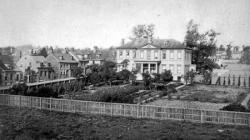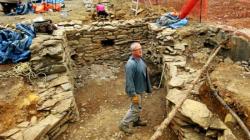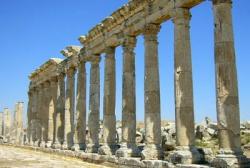- 21 SEPTEMBRE
- INDI-UNI : ANTHROPOLOGIE - ARCHEOLOGIE
INSCRIPTION 2011 – 2012 COURS A DISTANCE
REGISTRATION 2011 – 2012 ONLINE COURSES
- CANADA – 
 Halifax - Shoppers and tourists strolling boutique-lined Spring Garden Road during the summer saw history emerge at their feet – the foundations of a two-century-old mansion where Halifax’s elite once mingled with royalty. On a busy corner, archeologists have been uncovering the remains of Bellevue House, built in 1801 as the residence of the commander of British regiments stationed in the city, in search of clues to Halifax’s early history. In its 19th-century heyday, by one account, Bellevue was “the scene of many brilliant receptions, levees, balls, and other social events.” A newspaper story describes a two-and-a-half storey “almost palatial residence” with formal gardens that “present a pretty appearance.” “All kinds of royals trod the floors of that building,” said Garry Shutlak, senior reference archivist with the provincial archives. “Every member of the Royal Family that came to Halifax . . . would have visited there.” He’s certain Edward VII was entertained there as Prince of Wales in 1860. And Mr. Niven has found a reference to Edward’s son, the future George V, attending a ball at Bellevue as commander of a visiting warship.Queen Victoria’s father, the Duke of Kent, bought the land in 1800 while based in the city as commander of British forces in North America. He directed a building boom that transformed Halifax and left some of the city’s best-known structures, Mr. Shutlak notes, including the Town Clock and St. George’s Round Church.
Halifax - Shoppers and tourists strolling boutique-lined Spring Garden Road during the summer saw history emerge at their feet – the foundations of a two-century-old mansion where Halifax’s elite once mingled with royalty. On a busy corner, archeologists have been uncovering the remains of Bellevue House, built in 1801 as the residence of the commander of British regiments stationed in the city, in search of clues to Halifax’s early history. In its 19th-century heyday, by one account, Bellevue was “the scene of many brilliant receptions, levees, balls, and other social events.” A newspaper story describes a two-and-a-half storey “almost palatial residence” with formal gardens that “present a pretty appearance.” “All kinds of royals trod the floors of that building,” said Garry Shutlak, senior reference archivist with the provincial archives. “Every member of the Royal Family that came to Halifax . . . would have visited there.” He’s certain Edward VII was entertained there as Prince of Wales in 1860. And Mr. Niven has found a reference to Edward’s son, the future George V, attending a ball at Bellevue as commander of a visiting warship.Queen Victoria’s father, the Duke of Kent, bought the land in 1800 while based in the city as commander of British forces in North America. He directed a building boom that transformed Halifax and left some of the city’s best-known structures, Mr. Shutlak notes, including the Town Clock and St. George’s Round Church.
http://www.theglobeandmail.com/news/national/atlantic/archeologists-dig-up-mansion-to-reveal-halifaxs-royal-roots/article2173888/
- SYRIE –  Apamée - Several archeological sites in the ancient city of Apamea were vandalized and pillaged by groups taking advantage of the events in Syria to excavate secretly, dig randomly and steal artifacts in secret, damaging several finds including a mosaic and the crown of a column in the middle of the city.
Apamée - Several archeological sites in the ancient city of Apamea were vandalized and pillaged by groups taking advantage of the events in Syria to excavate secretly, dig randomly and steal artifacts in secret, damaging several finds including a mosaic and the crown of a column in the middle of the city.
http://www.sana.sy/eng/21/2011/09/20/370499.htm
- INDE –Gulbarga - The Bahmani dynasty, which ruled Gulbarga 600 years ago, left many monuments in Gulbarga region especially fort. The Archaeological Survey of India (ASI), which earlier neglected the fort, has now initiated development works on the 600-year-old structure to turn it into a tourist attraction. The fort, occupying an area of 200 acres of land and 3km, consists of two circular fortifications. The height of the outer wall is lower than the inner wall, with a 30 feet deep moat in between. In some areas, both walls have portions that have turned to rubble, which is now being repaired.
http://timesofindia.indiatimes.com/city/hubli/ASI-begin-repairs-on-Gulbarga-fort/articleshow/10057449.cms
- FRANCE – Bavay - Ce site archéologique présente les vestiges du plus grand forum de l'empire romain mis au jour en France (240 mètres de long sur 110 de large). Capitale des Nerviens, « les plus farouches des Belges » selon Jules César, l'antique Bavay devient Bagacum sous l'empire romain, rayonne sur le nord de la Gaule avant de péricliter au IIIe siècle. Des fouilles ont bien été réalisées au XVIIIe siècle, mais c'est véritablement en 1969, lors de la découverte du « trésor des bronzes » que des recherches d'envergure commencent. Un musée assez chiche s'élève à côté du site et entasse les découvertes. Les mauvaises langues y voient ruines et céramiques brisées. Mais en 2000, le musée est départementalisé, avant le site archéologique en 2008. Une politique de renouveau débute. Si, il y a encore peu, les visiteurs devaient s'imaginer une élévation du forum romain, aujourd'hui, l'imagination laisse place à une perspective architecturale concrète. Piliers, cryptoportiques, fondations des magasins et des boutiques du forum se découvrent distinctement. Le musée quant à lui offre une toute nouvelle muséographie « qui a gagné en cohérence », estime la directrice, Véronique Beirnaert-Mary. L'exposition permanente « Rendez-vous il y a 2 000 ans » entre en résonance avec les vestiges du forum et explique ses fonctions. Les centaines de pièces exposées (mosaïques, bijoux, statues), principalement déterrées autour de Bavay, illustrent ce projet. Quant à l'exposition temporaire, « Les murs murmurent », consacrée aux graffitis gallo-romains, elle interroge autant qu'elle promet de bons éclats de rire, tant elle surprend par sa grivoiserie.
http://www.lavoixdunord.fr/Region/actualite/Secteur_Region/2011/09/18/article_le-forum-antique-de-bavay-devoile-son-no.shtml
- FRANCE – Saint Leu d’Esserent - La renommée de Saint-Leu d’Esserent provient de l’imposant prieuré clunisien dont nous célébrons cette année le 930e anniversaire. Sa fondation, en 1081, est le fruit de la donation d’Hugues, comte de Dammartin, membre d’une famille illustre et puissante de l’Île-de-France. Durant tout le Moyen Âge, le prieuré resta un établissement prospère et dynamique. Situé sur la rive droite de l'Oise, le prieuré de Saint-Leu d'Esserent constitue une pièce majeure mais non isolée du vaste échiquier religieux de la région. La basse vallée de l'Oise apparaît notamment comme une zone d'implantation privilégiée du monachisme bénédictin, en dépit de la quasi-absence de grandes abbayes : Saint-Martin de Pontoise en est la seule représentante. Malgré cela, par la fondation de prieurés, les rives de l’Oise constituèrent un des terrains d’expansion des grandes abbayes de Cluny, de Molesme, de Jumièges ou de Saint-Denis. De taille, de fonction, d'organisation et de vocation différentes, les établissements prioraux sont inégalement connus car inégalement documentés mais, considérés dans leur ensemble, ils constituent, par la densité de leur réseau, les principaux acteurs de la vie monastique locale. D'organisation différente puisqu'elles ne possèdent pas de prieurés, les abbayes cisterciennes n'en sont pas moins très présentes dans l'espace proposé à l'étude, à travers des établissements de renom : Royaumont, Maubuisson et Le Val.
http://calenda.revues.org/nouvelle20818.html
- INDE – Chengalpet - They are over 1,000 years old but three rockcut shrines in Vallam near Chengalpet are seeing unchecked construction activity . These shrines belonging to the Pallava period are literally covered by cement as rooms have been constructed around them in violation of conservation rules . The main cave on the summit , called Vasanteshwaram , atop the hillock has a tiled floor and a grille at the entrance . Barring the main sculptures , a major portion of the original cave entrance has been painted a bright blue. Only the area of the pillars where three inscriptions - two in Tamil script , and the third in Pallava grantha - are carved remains untouched. The shrines , carved out of the boulders on a rocky hillock, date back to around 700CE and have inscriptions referring to Pallava king Mahendra Varman I, apart from Siva and Vishnu idols. "These are late Pallava shrines that were constructed after the period when the Pallavas excelled in building huge , structural temples had passed ," says conservation expert T Satyamurthy. Some of the sculptures , such as the prominently displayed mythological figure of 'Jeshta' , show the Pandya influence on the Pallavas . It was worshipped by the Pandyas who came later , says Satyamurthy . "It clearly indicates the changing political situation of the times ," he says.
http://timesofindia.indiatimes.com/city/chennai/Cement-structures-mar-1000-yr-old-shrines/articleshow/10061248.cms